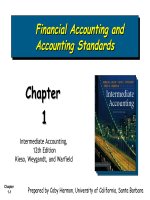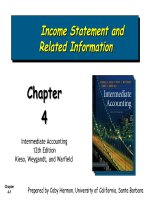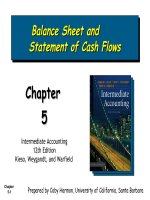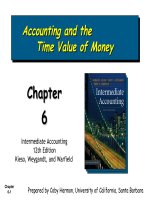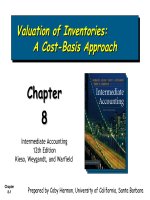Intermediate accounting 12th edition kieso warfield chapter 19
Bạn đang xem bản rút gọn của tài liệu. Xem và tải ngay bản đầy đủ của tài liệu tại đây (352.32 KB, 41 trang )
Accounting
Accounting for
for Income
Income Taxes
Taxes
Chapter
19
Intermediate Accounting
12th Edition
Kieso, Weygandt, and Warfield
Chapter
19-1
Prepared by Coby Harmon, University of California, Santa Barbara
Learning
Learning Objectives
Objectives
1.
Identify differences between pretax financial income and taxable
income.
2.
Describe a temporary difference that results in future taxable amounts.
3.
Describe a temporary difference that results in future deductible
amounts.
4.
Explain the purpose of a deferred tax asset valuation allowance.
5.
Describe the presentation of income tax expense in the income
statement.
6.
Describe various temporary and permanent differences.
7.
Explain the effect of various tax rates and tax rate changes on
deferred income taxes.
8.
Apply accounting procedures for a loss carryback and a loss
carryforward.
9.
Describe the presentation of deferred income taxes in financial
statements.
10.
Indicate the basic principles of the asset-liability method.
Chapter
19-2
Accounting
Accounting for
for Income
Income Taxes
Taxes
Fundamentals of
Accounting for
Income Taxes
Future taxable
amounts and
deferred taxes
Future deductible
amounts and
deferred taxes
Income
statement
presentation
Specific
differences
Rate
considerations
Chapter
19-3
Accounting for
Net Operating
Losses
Financial
Statement
Presentation
Loss carryback
Loss
carryforward
Loss carryback
example
Loss
carryforward
example
Balance sheet
Income
statement
Review of AssetLiability Method
Fundamentals
Fundamentals of
of Accounting
Accounting for
for Income
Income Taxes
Taxes
Corporations must file income tax returns following
the guidelines developed by the Internal Revenue
Service (IRS), thus they:
calculate taxes payable based upon IRS code,
calculate income tax expense based upon GAAP.
Amount reported as tax expense will often differ
from the amount of taxes payable to the IRS.
Chapter
19-4
LO 1 Identify differences between pretax financial income and taxable income.
Fundamentals
Fundamentals of
of Accounting
Accounting for
for Income
Income Taxes
Taxes
Financial Statements
Tax Return
vs.
Exchanges
Investors and Creditors
Pretax Financial Income
GAAP
Income Tax Expense
Chapter
19-5
≠
Taxable Income
≠
Tax Code
Income Tax Payable
LO 1 Identify differences between pretax financial income and taxable income.
Fundamentals
Fundamentals of
of Accounting
Accounting for
for Income
Income Taxes
Taxes
Illustration Assume the company reports revenue in
2007, 2008, and 2009 of $130,000, respectively.
The revenue is reported the same for both GAAP and
tax purposes. For simplification, assume the company
reports one expense, depreciation, over the three
years applying the straight-line method for financial
reporting purposes (GAAP) and MACRS (IRS) for the
tax return. What is the effect on the accounts of
using the two different depreciation methods?
Chapter
19-6
LO 1 Identify differences between pretax financial income and taxable income.
Book
Book vs.
vs. Tax
Tax Difference
Difference
GAAP
GAAPReporting
Reporting
Revenues
Expenses (S/L depreciation)
Pretax financial income
Income tax expense (40%)
Tax
TaxReporting
Reporting
Revenues
2007
2008
2009
Total
$130,000
$130,000
$130,000
$390,000
30,000
30,000
30,000
90,000
$100,000
$100,000
$100,000
$300,000
$40,000
$40,000
$40,000
$120,000
2007
2008
2009
Total
$130,000
$130,000
$130,000
$390,000
40,000
30,000
20,000
90,000
Pretax financial income
$90,000
$100,000
$110,000
$300,000
Income tax payable (40%)
$36,000
$40,000
$44,000
$120,000
Expenses (MACRS depreciation)
Chapter
19-7
LO 1 Identify differences between pretax financial income and taxable income.
Book
Book vs.
vs. Tax
Tax Difference
Difference
Comparison
Comparison
2007
2008
2009
$40,000
$40,000
$40,000
$120,000
Income tax payable (IRS)
36,000
40,000
44,000
120,000
Difference
$4,000
$0
$(4,000)
$0
Income tax expense (GAAP)
Total
Are the differences accounted for in the financial statements?
Year
Reporting Requirement
2007
Deferred tax liability account increased to $4,000
2008
No change in deferred tax liability account
2009
Deferred tax liability account reduced by $4,000
Chapter
19-8
Yes
LO 1 Identify differences between pretax financial income and taxable income.
Financial
Financial Reporting
Reporting for
for 2007
2007
Balance Sheet
Assets:
Income Statement
2007
Revenues:
2007
Expenses:
Liabilities:
Deferred taxes
4,000
Income tax payable 36,000
Equity:
Income tax expense 40,000
Net income (loss)
Where does the “deferred tax liability” get reported in the
financial statements?
Chapter
19-9
LO 1 Identify differences between pretax financial income and taxable income.
Temporary
Temporary Differences
Differences
A Temporary Difference is the difference between the tax
basis of an asset or liability and its reported (carrying or
book) amount in the financial statements that will result in
taxable amounts or deductible amounts in future years.
Future Taxable Amounts
Future Deductible Amounts
Deferred Tax Liability represents
the increase in taxes payable in
future years as a result of
taxable temporary differences
existing at the end of the current
year.
Deferred Tax Asset represents
the increase in taxes refundable
(or saved) in future years as a
result of deductible temporary
differences existing at the end of
the current year.
Illustration 19-22 Examples of Temporary Differences
Chapter
19-10
LO 2 Describe a temporary difference that results in future taxable amounts.
Future
Future Taxable
Taxable Amounts
Amounts and
and
Deferred
Deferred Taxes
Taxes
E19-1 South Carolina Corporation has one temporary
difference at the end of 2007 that will reverse and cause
taxable amounts of $55,000 in 2008, $60,000 in 2009, and
$65,000 in 2010. South Carolina’s pretax financial income
for 2007 is $300,000, and the tax rate is 30% for all years.
There are no deferred taxes at the beginning of 2007.
Instructions
a)
Compute taxable income and income taxes payable for 2007.
b)
Prepare the journal entry to record income tax expense,
deferred income taxes, and income taxes payable for 2007.
Chapter
19-11
LO 2 Describe a temporary difference that results in future taxable amounts.
Future
Future Taxable
Taxable Amounts
Amounts and
and
Deferred
Deferred Taxes
Taxes
Ex. 19-1
INCOME:
Financial income (GAAP)
Temporary Diff.
a.
Taxable income (IRS)
Tax rate
Income tax
a.
b.
Chapter
19-12
Current Yr.
2007
300,000
(180,000)
120,000
30%
36,000
Income tax expense (plug)
Income tax payable
Deferred tax liability
2008
55,000
55,000
30%
16,500
2009
60,000
60,000
30%
18,000
2010
65,000
65,000
30%
19,500
90,000
36,000
54,000
LO 2 Describe a temporary difference that results in future taxable amounts.
Future
Future Deductible
Deductible Amounts
Amounts and
and
Deferred
Deferred Taxes
Taxes
Illustration Columbia Corporation has one temporary
difference at the end of 2007 that will reverse and cause
deductible amounts of $50,000 in 2008, $65,000 in 2009, and
$40,000 in 2010. Columbia’s pretax financial income for 2007
is $200,000 and the tax rate is 34% for all years. There are
no deferred taxes at the beginning of 2007. Columbia
expects to be profitable in the future.
Instructions
a)
Compute taxable income and income taxes payable for 2007.
b)
Prepare the journal entry to record income tax expense,
deferred income taxes, and income taxes payable for 2007.
Chapter
19-13
LO 3 Describe a temporary difference that results in future deductible amounts.
Future
Future Deductible
Deductible Amounts
Amounts and
and
Deferred
Deferred Taxes
Taxes
Illustration
Current Yr.
INCOME:
2007
2008
2009
2010
Financial income (GAAP)
Temporary Diff.
Taxable income (IRS)
a.
Tax rate
200,000
155,000
355,000
34%
(50,000)
(50,000)
34%
(65,000)
(65,000)
34%
(40,000)
(40,000)
34%
Income tax
120,700
(17,000)
(22,100)
(13,600)
b.
Chapter
19-14
a.
Income tax expense
Income tax payable
Deferred tax asset
68,000
120,700
52,700
LO 3 Describe a temporary difference that results in future deductible amounts.
Future
Future Deductible
Deductible Amounts
Amounts and
and
Deferred
Deferred Taxes
Taxes
Deferred Tax Asset—Valuation Allowance
A company should reduce a deferred tax asset by a
valuation allowance if it is more likely than not
that it will not realize some portion or all of the
deferred tax asset.
“More likely than not” means a level of likelihood of
at least slightly more than 50 percent.
Chapter
19-15
LO 4 Explain the purpose of a deferred tax asset valuation allowance.
Future
Future Deductible
Deductible Amounts
Amounts and
and
Deferred
Deferred Taxes
Taxes
E19-14 Jennifer Capriati Corp. has a deferred tax asset
balance of $150,000 at the end of 2006 due to a single
cumulative temporary difference of $375,000. At the end
of 2007 this same temporary difference has increased to a
cumulative amount of $450,000. Taxable income for 2007 is
$820,000. The tax rate is 40% for all years. No valuation
account is in existence at the end of 2006.
Instructions
Assuming that it is more likely than not that $30,000 of the
deferred tax asset will not be realized, prepare the journal
entries required for 2007.
Chapter
19-16
LO 4 Explain the purpose of a deferred tax asset valuation allowance.
Future
Future Deductible
Deductible Amounts
Amounts and
and
Deferred
Deferred Taxes
Taxes
E19-14
Current Yr.
INCOME:
2006
2007
2008
(450,000)
(450,000)
-
40%
(180,000)
40%
-
Financial income (GAAP)
Temporary difference
Taxable income (IRS)
375,000
375,000
745,000
75,000
820,000
Tax rate
Income tax
40%
150,000
40%
328,000
Income tax expense
Income tax payable
Deferred tax asset
298,000
328,000
30,000
Income tax expense
30,000
Allowance for deferred tax asset
Chapter
19-17
30,000
LO 4 Explain the purpose of a deferred tax asset valuation allowance.
Future
Future Deductible
Deductible Amounts
Amounts and
and
Deferred
Deferred Taxes
Taxes
Deferred Tax Asset—Valuation Allowance
E19-14 Balance Sheet Presentation
Assets:
Deferred tax asset
Chapter
19-18
2007
$
180,000
Allowance for deferred tax
(30,000)
Deferred tax asset, net
150,000
LO 4 Explain the purpose of a deferred tax asset valuation allowance.
Income
Income Statement
Statement Presentation
Presentation
Illustration 19-20
Formula to Compute Income Tax Expense
Income tax
payable or
refundable
+
-
Change in
deferred
income tax
=
Income tax
expense or
benefit
In the income statement or in the notes to the financial
statements, a company should disclose the significant
components of income tax expense (current and deferred).
Chapter
19-19
LO 5 Describe the presentation of income tax expense in the income statement.
Specific
Specific Differences
Differences
Temporary Differences
Taxable temporary differences - Deferred tax
liability
Deductible temporary differences - Deferred tax
Asset
Text Illustration 19-22 Examples of Temporary Differences
Chapter
19-20
LO 6 Describe various temporary and permanent differences.
Specific
Specific Differences
Differences
Permanent differences are caused by items that (1)
enter into pretax financial income but never into taxable
income or (2) enter into taxable income but never into
pretax financial income.
Permanent differences affect only the period in which they
occur, they do not give rise to future taxable or deductible
amounts.
There are no deferred tax consequences to be recognized.
Text Illustration 19-24 Examples of Permanent Differences
Chapter
19-21
LO 6 Describe various temporary and permanent differences.
Specific
Specific Differences
Differences
Do the following generate:
Future Deductible Amount = Deferred Tax Asset
Future Taxable Amount = Deferred Tax Liability
A Permanent Difference
1. The MACRS depreciation system is used for tax purposes, and the
straight-line depreciation method is used for financial reporting
purposes.
Future
Taxable
Amount
2. A landlord collects some rents in advance. Rents received are
taxable in the period when they are received.
Future
Deductible
Amount
3. Expenses are incurred in obtaining tax-exempt income.
Permanent
Difference
4. Costs of guarantees and warranties are estimated and
accrued for financial reporting purposes.
Future
Deductible
Amount
Chapter
19-22
LO 6 Describe various temporary and permanent differences.
Specific
Specific Differences
Differences
Do the following generate:
Future Deductible Amount = Deferred Tax Asset
Future Taxable Amount = Deferred Tax Liability
A Permanent Difference
5. Sales of investments are accounted for by the accrual method for
financial reporting purposes and the installment method for tax
purposes.
Future
Taxable
Amount
6. Proceeds are received from a life insurance company because of the
death of a key officer (the company carries a policy on key
officers).
A
Permanent
Difference
7. Estimated losses on pending lawsuits and claims are accrued for
books. These losses are tax deductible in the period(s) when the
related liabilities are settled..
Future
Deductible
Amount
Chapter
19-23
LO 6 Describe various temporary and permanent differences.
Permanent
Permanent Differences
Differences
E19-4 Zurich Company reports pretax financial income of $70,000
for 2007. The following items cause taxable income to be different
than pretax financial income. (1) Depreciation on the tax return is
greater than depreciation on the income statement by $16,000. (2)
Rent collected on the tax return is greater than rent earned on the
income statement by $22,000. (3) Fines for pollution appear as an
expense of $11,000 on the income statement.
Zurich’s tax rate is 30% for all years, and the company expects to
report taxable income in all future years. There are no deferred
taxes at the beginning of 2007.
Instructions Prepare the journal entry to record income tax
expense, deferred income taxes, and income taxes payable for 2007.
Chapter
19-24
LO 6 Describe various temporary and permanent differences.
Permanent
Permanent Differences
Differences
E19-4
Current Yr.
Deferred
Deferred
2007
Asset
Liability
INCOME:
Financial income (GAAP)
$
Excess tax depreciation
Excess rent collected
(16,000)
22,000
Fines (permanent)
Taxable income (IRS)
$
$
11,000
87,000
Tax rate
$
26,100
30%
$
(6,600) $
Income tax expense
24,300
Deferred tax asset
6,600
Deferred tax liability
Income tax payable
16,000
(22,000)
(22,000)
30%
Income tax
Chapter
19-25
70,000
16,000
-
30%
4,800
-
4,800
26,100
LO 6 Describe various temporary and permanent differences.


